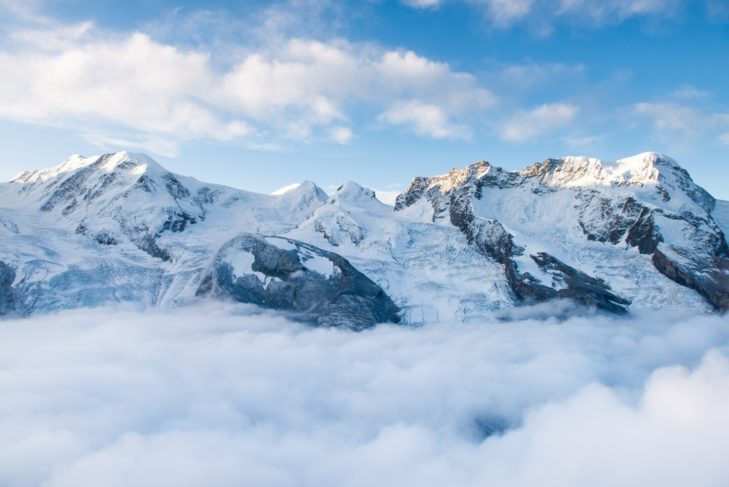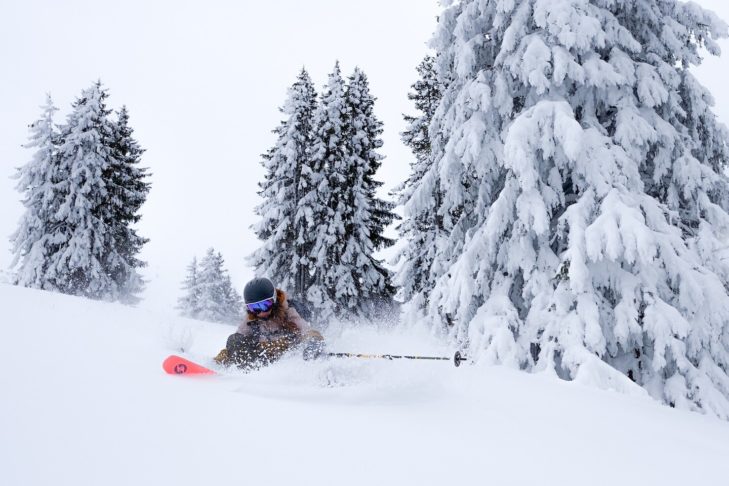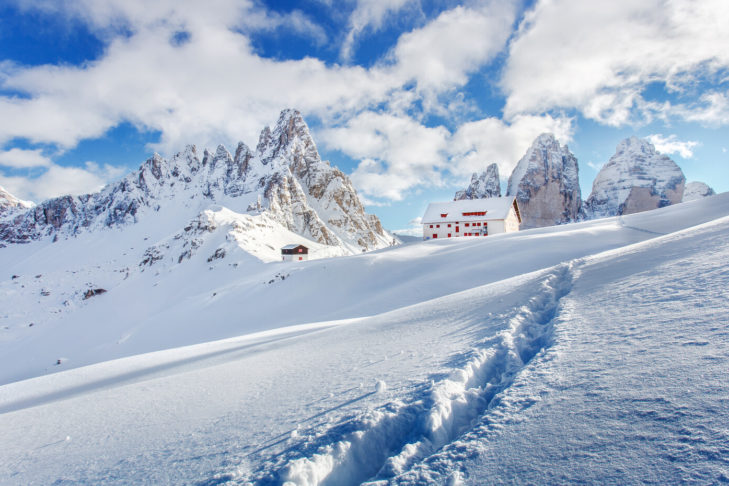Every winter sports enthusiast knows what it’s like: getting up in the morning, going to the window, carefully pulling the curtains aside and thinking: “Hopefully good skiing weather today”. And if it’s not exactly glorious sunshine, the view of the sky can sometimes be puzzling. Because when it’s cloudy, the question arises: How are these clouds to be understood? SnowTrex explains exactly what the different types of clouds reveal about the current mountain weather and what they mean for skiing.
| Cloud type | Altitude | Weather conditions |
|---|---|---|
| Layered/stratus clouds | 0.0 to 5 km | Drizzle |
| Rain clouds | 0.1 to 6 km | Rain/snow |
| Cluster/cumulus clouds | 0.5 to 2.5 km | Cloudy |
| Storm clouds | 0.5 to 11 km | Thunderstorm |
| Fleecy clouds | 2.5 to 12 km | Rain/snow |
| Lenticular clouds | 3 to 6 km | Foehn |
| Mammatus clouds | 5 to 10 km | Rain/thunderstorm |
| Veil/cirrostratus clouds | 6 to 10 km | Approaching rain |
| Feather/cirrus clouds | 6 to 12 km | Clear/sunny |
What are clouds?
Clouds are formed when water droplets adhere to small particles in cold layers of air. This makes them visible in the sky as condensed water vapour. As clouds can be at different heights, they can be roughly divided into four categories: low clouds (0 to 3 km above the ground), medium-high clouds (2 to 7 km), high clouds (7 to 12 km) and clouds that extend vertically over several of these “storeys”. Clouds, which are not always rain clouds, always take on the ambient temperature, making them very cold at high altitudes, unlike at ground level.
They can also be categorised according to their appearance: Cumulus clouds, for example, popularly known as fleecy clouds, are formed by rising air. Stratus clouds, also known as stratus clouds, are formed when warm air pushes over cold air. But what do the different types of clouds actually mean? And what should winter sports enthusiasts be prepared for when they see veil clouds in the sky?
Please also note that by using our services and integrating the YouTube API Services, the YouTube Terms of Service and the YouTube API Services Terms apply and your use of our website is deemed to be acceptance of these terms.
Weather with stratus clouds
Layered clouds (stratus) are also categorised into different “storeys”, as they can form directly above the ground or up to 5 km above the ground. When mid-level stratus clouds – known as “altostratus” – form, the sky initially clouds over slowly but steadily. For winter sports enthusiasts, this means that visibility on the piste becomes increasingly poor and the weather conditions soon change with precipitation.
Weather with rain clouds
A rain cloud, which turns into a snow cloud at higher, colder altitudes, also known as a nimbostratus, also forms in several levels in the sky between 100 metres and 6 kilometres high. This cloud form barely lets the sun through, which is why its underside can usually appear from a light grey to almost black. If this type of cloud appears, it means, as the name suggests, that it will soon rain or even snow in the mountains! The precipitation can make poor visibility on the slopes dangerous for skiers. Depending on the amount of snow, the probability of avalanches in the ski area increases, especially away from the pistes.
Weather with stratocumulus clouds
Cluster clouds or stratocumulus clouds can easily be mistaken for cumulus clouds, which can be challenging for mountain enthusiasts. The key difference: While cumulus clouds usually signal plenty of sunshine, stratocumulus clouds, forming at altitudes between 500 meters and 2.5 kilometers, typically only indicate an improvement in the weather. These clouds form primarily in mountainous regions, as the wind rapidly pushes moist air masses over the peaks. As the air cools, stratocumulus clouds tend to develop. Like many other cloud types, they often get “stuck” in mountain ranges such as the Alps, where the peaks act as a natural barrier, forcing the clouds to slowly rise along the slopes before reaching the summits.
Please also note that by using our services and integrating the YouTube API Services, the YouTube Terms of Service and the YouTube API Services Terms apply and your use of our website is deemed to be acceptance of these terms.
Weather with storm clouds
When small fleecy clouds grow rapidly in height, this is a sign of an imminent change in the weather. This is because the initial fleecy clouds quickly develop into thunderclouds, which are among the most dangerous clouds of all and are also known as cumulonimbus or ambos in technical jargon. They pass through several “storeys” between 500 m and 11 km high and herald thunder and lightning, which can be dangerous for skiers outdoors on the piste.
Weather with fleecy clouds
Cumulus clouds, commonly known as fleecy clouds, usually form in stable high-pressure weather at an altitude of 2.5 to 12 kilometres. And they get every winter sports enthusiast’s blood pumping, as they promise a sunny day without any changes in the weather. However, caution is advised when the fleecy clouds rise quickly. This can be a sign of approaching rain or snow in the mountains.
Weather with foehn clouds
Like the fleecy cloud, the foehn cloud belongs to the cumulus cloud category. They are also referred to by weather experts as “altocumulus lenticularis” and occur at an altitude of 3 to 6 kilometres, where they form the round shape of a UFO. These clouds form when the foehn wind blows on the mountain ridges, precipitation falls in the stagnant areas of the wind and warm, sunny Alpine weather prevails on the leeward side of the mountain – i.e. the side facing away from the wind. Meaning: If the ski area is on the leeward side, winter sports enthusiasts and mountain lovers are lucky with the weather. At the summits, however, strong gusts of wind can also occur here, which then pose a danger to skiers.
Weather with mammatus clouds
Mammatus clouds are unusual, bag-like cloud formations that form on the underside of thunderclouds. There is usually strong turbulence in their vicinity. In addition, the formation of mammatus clouds heralds possible thunderstorms, which means an increased risk of a sudden change in weather conditions for skiers in the mountains. This type of cloud occurs at an altitude of 5 to 10 kilometres.
Weather with veil clouds
Veil clouds, also known as cirrostratus, stretch like translucent veils across the entire sky at an altitude of 6 to 10 kilometres. When skiers and snowboarders see this type of cloud, they can usually assume that it will rain or snow around 36 hours later.
Weather with feather clouds
Feather clouds, also known as cirrus clouds or ice clouds, are the highest of all cloud types at a height of 6 to 12 kilometres in the sky. In the singular, weather experts speak of cirrus, which means “tuft of hair”. This describes their appearance quite well, as they are fine, scattered, thread-like clouds whose edges are mostly frayed. The jet trails that aeroplanes leave in the sky every day also belong to this category. Cirrus clouds usually herald the arrival of a warm or cold front in sunny weather.
What will the weather be like in the Alps next week? The snow weather forecast for each destination can be viewed via SnowTrex:
- Snow depths & weather Austria
- Snow depths & weather France
- Snow depths & weather Switzerland
- Snow depths & weather Italy
- Snow depths & weather Germany
- Snow depths & weather Andorra
FAQ’s on clouds and mountain weather
What do cumulus clouds mean for skiing weather?
Cumulus clouds, often also called fleecy clouds, form at an altitude of 2.5 to 12 kilometres and are usually a sign of stable high-pressure weather that promises sunny conditions for winter sports enthusiasts without weather changes.
How do foehn clouds affect the weather in the ski area?
Foehn clouds, also known as “Altocumulus lenticularis”, occur at an altitude of 3 to 6 kilometres and form in foehn winds. On the side of the mountain facing away from the wind, they often herald sunny weather. At the summits, however, they can also lead to strong gusts of wind that can be dangerous for skiers. Rapidly rising foehn clouds, on the other hand, are often a sign of imminent rain or snowfall.
What weather changes should skiers be prepared for in the event of storm clouds?
The rapid growth of small fleecy clouds into storm clouds, also known as cumulonimbus, indicates an imminent change in the weather. These clouds, which are between 500 m and 11 km high, signal lightning, thunder and possible dangers for skiers on the slopes.
How do the weather conditions change for skiing when stratus clouds form?
Layered clouds (stratus), which can form at various altitudes up to 5 km, slowly cloud the sky and reduce visibility on the piste. Medium-high stratus clouds, known as altostratus, often herald impending precipitation.
What does the appearance of mammatus clouds mean for winter sports enthusiasts?
Mammatus clouds are unusual, baggy cloud formations that occur at an altitude of 5 to 10 kilometres and herald strong turbulence and possible storms. Their appearance means an increased risk of sudden weather changes for skiers in the mountains.






